Sometimes when Notre Dame plays down the level of inferior competition, there are bright spots and data to brush off those concerns. The Toledo game last year is a good example – it easily could have been an embarrassing loss, and was zero fun to watch. But the Irish had higher yards per play, a +17% success rate margin, and had a few extremely costly plays (explosive gains given up, the Coan pick-six) that put the game in jeopardy.
The loss to Marshall was not one of those games. Yes, there was a -3 turnover margin that hurt Notre Dame immensely. But look at the core phases of the game, and Marcus Freeman’s team simply was worse all-around. The Thundering Herd were +0.5 yards per play better, doubled up ND in red zone trips 4-2 (neither team scored from outside the opponent 20), and both teams had efficiency rates around 50%. The Irish were lucky that Charles Huff twice settled for field goals inside the five-yard line, although if part of the rationale was trusting his defense, well, he was right.

There are far more questions than answers after this shocking loss, but the most jarring development so far has been the weakness of this Notre Dame team on both lines. What gave beat writers, fans, analysts, and even Vegas (8.5 wins suddenly feels very respectful!) confidence about this edition of the Irish was the projected ability to control the point of attack. Even if Tyler Buchner had growing pains as a starter, the wide receiver depth was an issue or the secondary struggled again, the conventional wisdom was that the combination of veterans and young prospects on the OL and returning pieces and depth in the defensive front seven would carry things in most games.
Stats from a few excellent sources – College Football Data, Game On Paper, and often referencing SP+ and FEI numbers. If you get lost, check out this handy advanced stats glossary here or reach out in the comments.
No Real push = No Real Plan
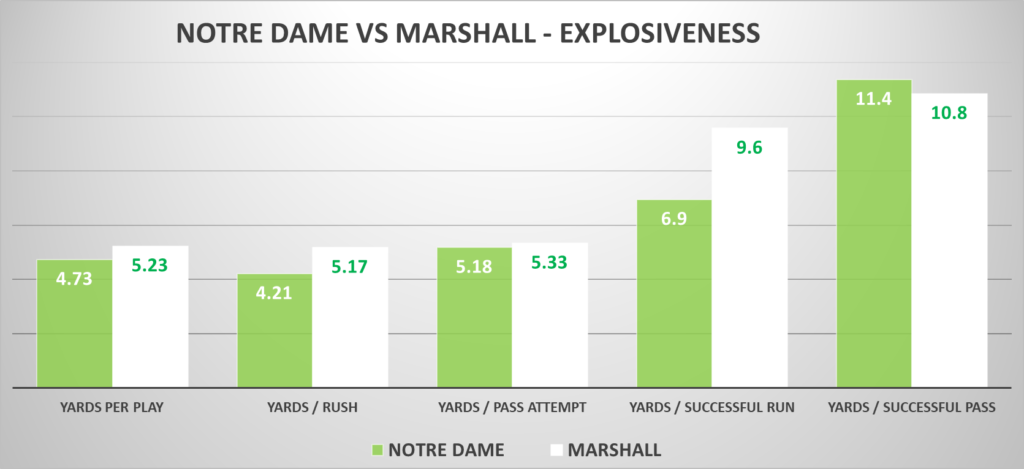
So what in the world is this? Let’s start with the offense, which has never looked cohesive or comfortable in two games. Against Marshall, the offensive line proved that they were the main variable responsible for the rushing struggles against Ohio State – not the caliber of the opponent, not the hostile road environment, not the absence of Jarrett Patterson. Despite eventually leaning on Tyler Buchner’s legs more, 4.2 yards per rush against a G5 opponent was dreadful in what needed to be a bounce-back game.
Even more concerning, most of the success running the ball came from the non-running backs. With the line struggling and the passing game disjointed, running the ball with Buchner and ten blockers was the best thing the offense had going. That element is gone with Buchner out for the season with a season-ending shoulder injury requiring surgery.
- RB carries vs. Marshall: 20 carries, 57 yards (2.85 / attempt), 35% success rate
- Non-RB carries: 14 carries (11 for Buchner), 86 yards (6.14 / attempt), 78.6% success rate
It’s hard to explain how this group is struggling so badly. There’s poor communication and poor execution. Much like the beginning of last year, it’s hard to evaluate the running backs because they have so few opportunities with open space. Last year the continuity with Kyren Williams at least gave a consistent barometer; this year all we know is that things are ugly no matter which back gets the hand-off. And defenses will continue to throw numbers in the box until this Notre Dame group proves it can pose a consistent threat downfield.
A thin passing attack without complementary parts
Tommy Rees opened up the offensive gameplan after a ball-control approach against Ohio State, passing on 53% of early downs after only 33% in Columbus. While passing dropbacks outgained rush attempts, 5.18 yards per attempt was a woeful effort from the ND passing game.
It wasn’t all dark, though, as Eric pointed out in his recap. Michael Mayer continues to be a saving grace for the offense, with his 13 (!) targets averaging 7.92 yards per play and successful plays on 8 of those passes. Looking Lorenzo Styles way wasn’t quite as efficient, but 11 passes his way were good for 6.27 yards per throw and another healthy success rate (54.5%).
The problem was the lack of other threats – even removing sacks, the remaining 14 pass attempts to Braden Lenzy (6), Jaden Thomas (4), Kevin Bauman (2), and Chris Tyree (2) averaged 3.5 yards per throw. There was simply zero secondary playmaking from this cast, which isn’t all on them and may have much to do with how they are utilized. Without complementary contributions from the rushing game, this is an offense that still feels laborious and easy to defend, and the Thundering Herd capitalized on it by making most of the biggest plays of the game on defense:
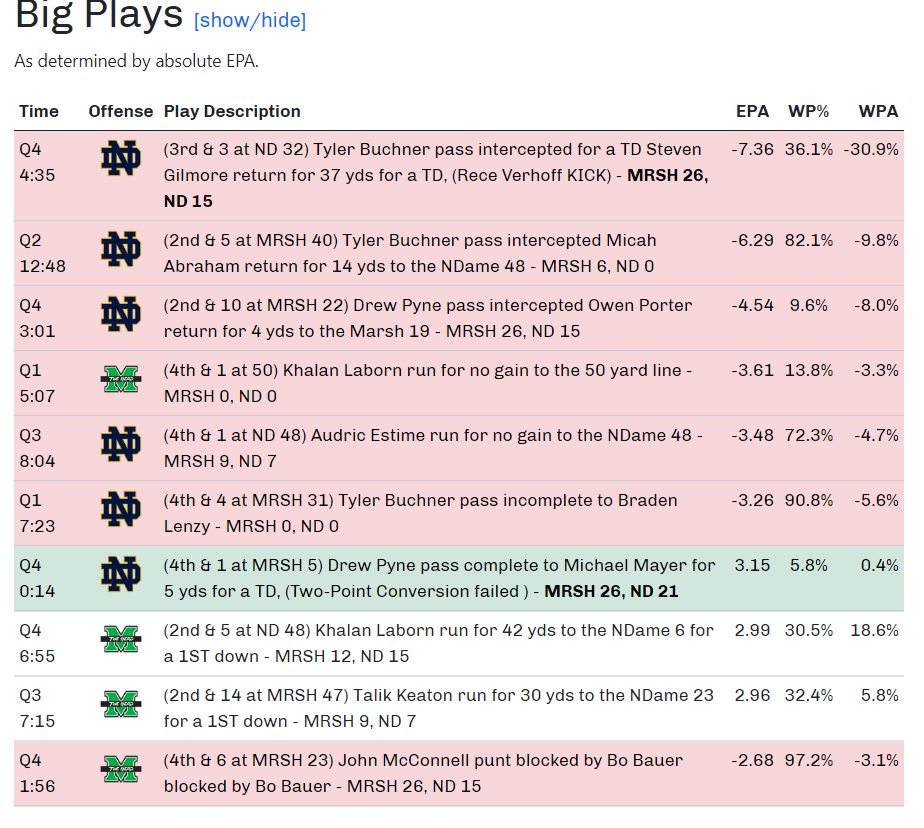
Tommy Rees is a justifiable punching bag with the early offensive performance. And while he received a lot of credit for engineering last season’s offensive makeover, there’s now a disturbing trend of starting new seasons without a great grasp of what the offense is working with and how to play to their strengths quickly. The always-terrific Jamie Uyeyama unearthed some terrific numbers that highlight how poorly Notre Dame played to Buchner’s strengths with their calls on Saturday:
Why didn’t Notre Dame attack the perimeter more? Why did they continue to try and run inside when they were having almost no success? I honestly have no idea why we didn’t see more of it, especially after it sparked Notre Dame’s first touchdown drive. On designed runs inside the tackles, they rushed for 52-yards on 20 carries (2.6 per carry). On perimeter runs/passes that were behind the line of scrimmage, they had 10 plays for 82 (8.2 per play).
ISD’s Matt Freeman already included the play-action numbers from this game for Tyler Buchner. For those that missed it, he was 9 of 11 on play-action drop backs and averaged 12.0 yards per attempt. On standard drop backs without play-action it was much worse: 9 of 21 3.3 YPA and two interceptions. If you look at Buchner for his career at Notre Dame so far, it’s an 80% completion rate and 12.2 YPA on play-action for him. It’s 45.6% 5.6 YPA when not running play-action.
Last year proved that offensive line performance, like any position group, isn’t static. Still, Rees has to be prepared with plans for if the line is or isn’t clicking and show a quicker ability to adapt based on early returns. With Drew Pyne taking over, the options become even more limited, but at the very least there may be a clearer understanding of what is on and off the table with Pyne.
A defense that’s healthier but not dominating
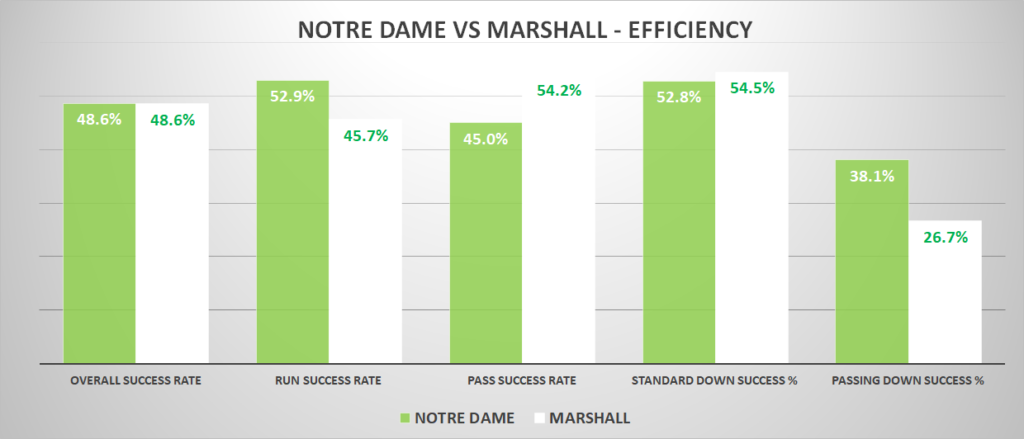
There are fewer glaring pimples for the defense, which was only responsible for 19 points surrendered against the Herd. But it still counted as an underwhelming effort against a Sun Belt team, as Marshall posted solid efficiency numbers and was rarely thrown into difficult situations (just 15 passing downs of 70 plays).
A good stat for measuring how easily a team is moving the ball is available yards. The number of available yards for each possession is the distance from where you start to the opponent’s end zone (a touchdown would be 100%). What percentage of those yards do you gain throughout the game? Marshall was at a shade below 50% of available yards gained, which would have been the 4th highest total for the Notre Dame defense in 2021. It doesn’t bode well for facing upcoming attacks like North Carolina, BYU, a revamped Syracuse attack, and USC.
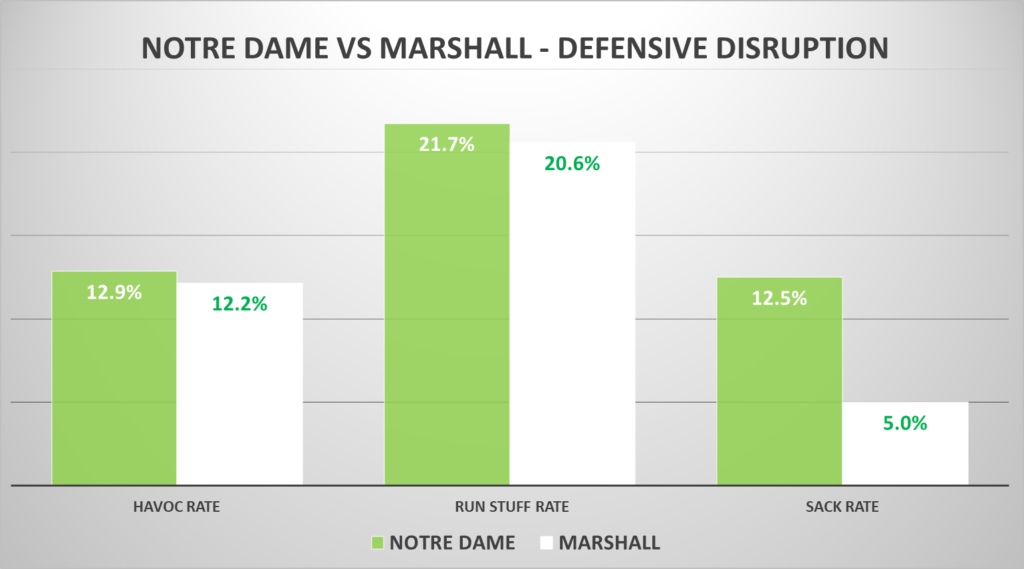
The defense feels like many of the recent Irish past – very solid but rarely dominant for large stretches. The lack of disruption so far plays a big role in that – Notre Dame has forced zero turnovers and minimal opportunities for them. Al Golden’s defense forced zero fumbles through two games and has only broken up two passes, including zero against Marshall.
The Notre Dame stuff rate (runs for no gain or a loss) looks solid on paper but reflects that the Irish have been disruptive only situationally. Of the ten run stuffs against the Thundering Herd, four came with Marshall inside the Notre Dame ten-yard line, one was on fourth down and one, and two were on the final real Herd possession of the game (an obvious run-out-the-clock situation). It’s both great to have these valuable stops and concerning there’s much less disruption on normal plays that aren’t high percentage runs.
On to lower expectations
Notre Dame is realizing the trade-off to hiring Freeman in a much more immediate and painful way than anticipated. There was near-unanimous approval of the hire – take the gamble on upside and potential, lack of track record be damned – aren’t these things a crap-shoot anyway? But a significant part of the pitch was also the continuity – that Freeman inherited an extremely healthy program, that the top offensive and defensive minds remained on staff, and a positive culture would be preserved with key figures like Matt Balis remaining in South Bend.
The losses to Oklahoma State and Ohio State were still respectable performances as a whole despite dark spots. The loss to Marshall – certainly not a bad team, but one that should look very underequipped to deal with Notre Dame – was a canary in the coal mine. The assumed strengths of this team have been gashed, and the fears about weak spots on the roster have all come to life in a hurry. Buchner’s season-ending injury is a hit to short-term success and the ability to plan long-term for the position.
There’s not much left to do but recalibrate expectations. The inexplicably poor performance of both lines has to be looked at from every angle and improved – these guys simply are too talented to play this poorly. It’s too much to ask for the other spots on the roster to suddenly carry this team. The construction of the team depends on advantages at the point of attack – to give rushers room, put less of a burden on inexperienced QBs, preserve the thin receiver room, free up linebackers to make plays, and give the growing secondary more margin for error. It will require a turnaround from within the trenches, otherwise, there are very few wins remaining on the schedule.
The defense can and must still be solid, especially against the less talented offenses on the schedule. With Pyne under center, the best chances are probably straight out of Freeman’s mentor Jim Tressel’s playbook. Don’t put too much pressure on your QB, allow him some easy looks to your best receivers, and hope your OL can play better most weeks. Make sure every drive ends with a kick, and hope your defense can regain their edge and begin forcing some takeaways that lead to easy points. Win on special teams. Grab some ugly 20-17 wins and keep the momentum going on the recruiting trail, and learn from these early struggles. Aspiring to become blue-chip Iowa (from last year! things aren’t THAT dark on offense) is a rough recalibration, but that’s where things stand.
Assuring a bowl berth in any way possible and keeping recruiting momentum should be the new priority goals. Playing spoiler and gaining a big win along the way against teams like BYU, Clemson, or USC? Icing on the cake. The advanced stats systems, including sportsbooks using them, phase out long-term results slowly for a reason. The next few weeks will prove whether that process is wise to apply to this Notre Dame team with underperforming talent that can bounce back, or if this disappointment was a clear harbinger of what’s to come.

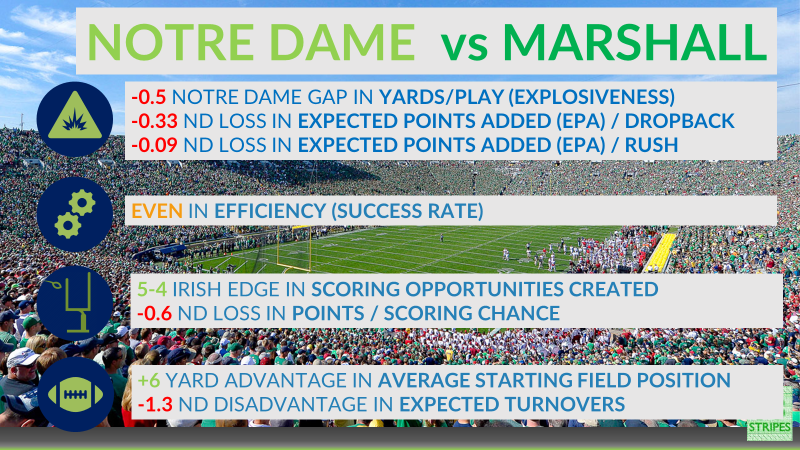
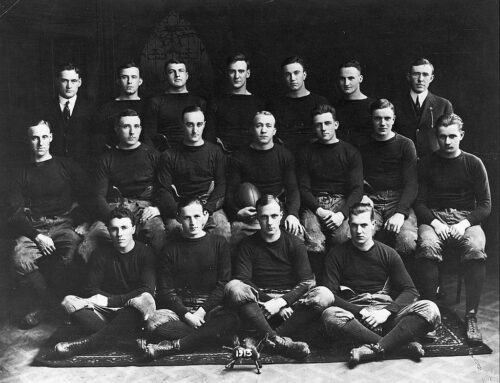


I want to read it, but I don’t.
Is there scatter data out there on passing trends by teams? Or even bucketed data like they show during NFL games sometimes left/middle/right short/long?
I ask because I believe ND has completed one shallow slant to a WR in the first two games, and even though a lot of Mayer’s work has been over the middle it seems like the passing concepts are ridiculously weighted toward outs and hitches outside the numbers, which obviously encouraged Marshall to jump those routes a lot last Saturday.
Even if the WRs suddenly get better at coming back and fighting for balls those aren’t the easy-on-the-QB concepts out of the Tressel playbook.
I think PFF has some of this data but sadly not for free.
Agree that there’s been a lot to the sidelines, some of that focus maybe in an attempt to have simpler reads for Buchner? Not the expert there but yes more diversity would be good…that said, with our new starting QB not cracking 6′, visibility over the middle could be a concern. I saw some heat maps of Russell Wilson with the MNF game and last year in Seattle, and a very similar trend!
If I’m reading this right PFF shows Buchner has thrown the most passes between the numbers at a depth between 0-10 yards. He’s 10/14 in that region.
There are 18 passes attempted down the right or left sides.
21 passes between the numbers at all depths.
(I left out anything behind the line of scrimmage).
I might add that against Marshall Buchner threw on the sides 9 times and and down the middle 17 times (most within 10 yards of the LOS). Again I’m not including anything behind the LOS.
We don’t like those throws over the middle. Lenzy was wide open deep at the end of the half. The two throws up the seam to Bauman, one in each game and both wide open, and that is about it.
I think back to the TD throw by Pyne to Austin in the Wisconsin game. Have we seen that route (let alone success) on that route all season? Thomas and Styles are big enough to run the middle. So are Colzie and Merriweather. I know Colzie is hurt, but we need to play Merriweather. Getting Wilkins back, slowly, doesn’t really help because he doesn’t run the middle of the field.
Until we force the LBs to drop occasionally or position another yard or two off the line, there will always be six in the box, and our OL can’t really block 4. With 6 in the box and five in coverage, it will always be a long day for our offense.
We never have under Rees, for some reason (kind of like rarely using play action). Go back the past two years and there isn’t much over the middle stuff; I initially thought that Book couldn’t see over the line, but he’s gone and it’s still happening.
Well, I had a whole thing written up about how maybe things aren’t so bad because this ND team isn’t really that different from last year’s and could have the same kind of September turnaround.
Then I read this. Yeesh.
Yea, I think the hope has got to be that the lines (esp.) start to play up to their talent level. The OL is still either relatively young or inexperienced so there’s room to grow (and apparently most of them are still pretty talented).
The DL – Cross actually played elite vs Marshall – and Foskey needs to play back up to his talent level. Mills is someone who is young and could grow as the year goes on.
If the lines can start carrying their weight (pun intended), then this team could limp along and just enough to win a decent amount of games – being very good on defense and acceptable on offense. So that’s the hope but without seeing another game, I don’t know how hopeful to be that that will actually happen.
And either way, while it’s concerning that Rees has started off not knowing what he has, he did in fact learn and turn it around conceptually on offense. So here’s hoping he can adapt on offense to what we actually can do and that he does more of it. Hopefully a new QB at the helm doesn’t slow down this process too much (like now he’s got to take 2 games to learn what Pyne can do or something like that).
Last year, Week 3 was when we started looking like a normal, competent-ish football team, so maybe that will happen again?
Yea, one hopes so. You’d think Marshall could be the wake-up call. Like we aren’t as good as we think we are and so we need to adjust schemes/play harder, etc.
We still could have key weakness but we really should have some strengths too. But we didn’t seem to see any of those strengths against Marshall. Even the law of averages would even this out a little bit (close game against top 5 OSU – close game against sun belt team – who may turn out to be pretty decent): somewhere in the middle still could be like 25-35ish. Which at this point would be a big win and probably enough to keep the recruiting flowing.
Then again, we still had that heart attack game against a meh VT team.
Right after losing to Marshall it feels like 2007 or 2016, but surely the best corollary to where we are today is 2011.
That’s a sentence that perfectly describes both 2011 and 2022. In 2011 we went on to win 8 of the next 9 then play for a National Championship the next year. 2022, despite the pain so far, we’re double digit favorites against a 2-0 team this week. There’s still time to play a lot of good football this year as long as we start this week.
I’d feel better about that comparison if we had our starting QB for the year or if our backup was more solid.
When was the last time we lost our starting QB for the most of the year when the starter was a clear #1 and the backup and clear #2 (in other words with a clear divide between them)?
This just seems like the worst QB situation in a long time. For the next 10 games it’s Pyne/Angeli. What other QB room would even remotely compare to that for ND? Yikes.
I know some big Malik fans who would say 2015, but I get the impression from the way you’ve worded it you want to exclude the Ziare to Kizer handoff, which would push it back to 2010, which, if we count the Marshall loss as the Tulsa loss (the game we lost the starter) we won the last 4 games of that year including the hilarious bowl game where Maimi’s team nearly perished in the Texas snow flurries.
You’re totally right about the QB situation, unfortunately, and other people have touched on it before me, but absent something unexpected happening at this point QB is going to be a pain point going into next season too, which makes it all even worse.
Yea that’s what I was thinking in terms of Zaire/Kizer. At the very least, one could say (hindsight being 20/20 and all that) that Kizer was a really good player. And at the time, I think we all figured he was talented (at least not so far behind Zaire in terms of talent) and we just hadn’t seen much of him.
This year I don’t think many think Pyne is particularly talented and we’ve seen more of him I think than we had Kizer at that point.
That’s true – 2010 is likely it. A freshmen Rees and whatever Nate Montana right? An athletic Hendrix got some snaps at some point too that year, no? (Or was that Standard game the following year?)
Though they had Floyd and Rudolph to throw to. Eifert was sophomore but did he play much that year? I would feel a whole heck of lot better if Pyne were throwing to two first rounders. (I know everyone says Mayer is great, and he is, but he’s not quite the same threat as Rudolph or a first round TE – or so it seems to me anyway. Just not quite the breakaway speed that Eifert/Rudolph had.)
The closest comparison is probably 2007. Buchner as Demetrius Jones (out of the picture after 2 games), Pyne as Sharpley (overwhelmed backup), and Angeli as Clausen (NFL prototype, but a freshman).
2010 at least had theoretical 5-star Dayne Crist for a while.
In week 3 of 2011, we shithammered a very good Sparty team 31-13. My memory — and this could totally be wrong — is that we just stopped turning the ball over and suddenly looked like a normal, competent football team.
Hopefully we beat Cal 31-13 too, but I don’t see one particular glaring flaw on this team that can be fixed in a week, like the turnovers in 2011. 2007 is closer to where we are right now, unfortunately.
I’ll mostly disagree… I agree with you that there’s more than one problem, but I would argue that there is most definitely one particularly glaring flaw and that’s the offensive line. If they can pull their head out of their collective posterior the offense will look radically different even with its other shortcomings. The D has actually been pretty good, all things considered; plenty of things to fix there too, don’t get me wrong, but they don’t have the fatal flaw that the offense does. Giving up 21 to Ohio State on the road is a significant marker, and giving up 19 to Marshall wouldn’t have turned anyone’s heads if the offense hadn’t netted 14 (the 21 scored minus the pick six given up).
The coaches have a lot of work to do and certainly underestimated how much of the recent culture was self-sustaining. But I do think there’s one massive factor that could right the ship (mostly) if it’s fixed quickly.
That’s fair. I was just thinking that OL reminds me more of 2007 as well — just shockingly bad play that’s hard to even wrap your head around. I do agree that if we can have a revelation on OL a la mid-2021, things will suddenly look a lot better.
“With Drew Pyne taking over, the options become even more limited, but at the very least there may be a clearer understanding of what is on and off the table with Pyne.”
Not being (entirely) snarky when I ask: do you mean that in the sense that we know, for sure, that Pyne isn’t going to be good at anything? That’s… quite a silver-lining way to look at that situation.
I said at the very least haha!
But I think it’s more in contrast to Buchner, where it seemed like there was some reluctance to decide how much to lean on his legs versus let him be aggressive in the passing game. While Tommy publicly said he doesn’t think the scheme changes too much, I’m not buying it – I think this creates a bit of a clearer divide with what you want to do with the run game (very little Pyne involvement) and the passing game.
I am worried for Pyne though. Pre-season if you told me Buchner would go down, I think I’d still feel pretty confident. But getting a solid passing attack will require most of 1) good Pyne, 2) something from OL competence to good play, 3) WR health and good performance by guys not named Styles, and 4) Tommy putting together good plans. My concern is that even with #1 happening the results may not be great because of everything that has to get right #2-4.
Not a technically or tactically knowledgeable football watcher but it seemed like the one successful scoring drive end of 3rd and beginning of 4th quarter had higher tempo than the previous drives. I just looked through the play by play logs and it was 8 plays in just under 4 minutes which doesn’t seem particularly fast, but it “felt” like more tempo when watching. Tempo seemed to be the solution to some of the OL woes last year.
Separate note, as I was watching ND take the field on the Buchner’s last possession the skycam went over him and the ref as he stepped behind the line and I thought something along the lines of “there’s 10 other guys out here young man, you don’t have to carry it all” and four plays later he’s down for the count. Oof.
So my take away is that we should just run the single wing and we’ll be successful on 75% of the runs.